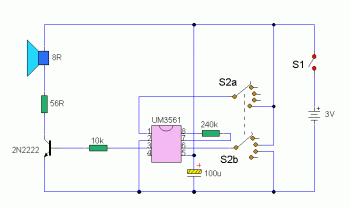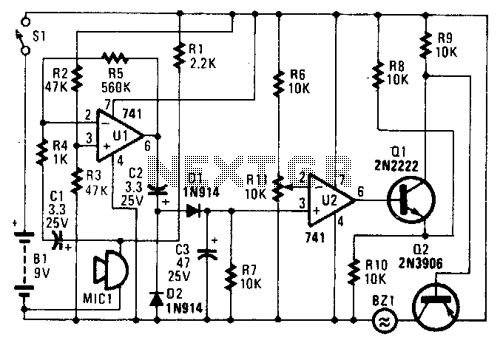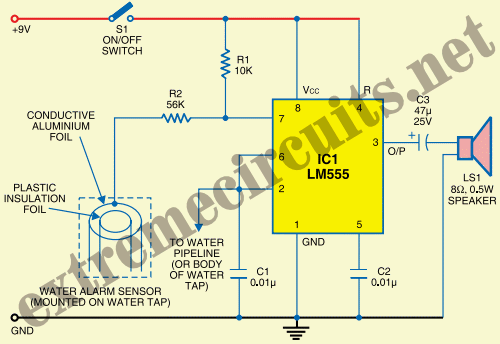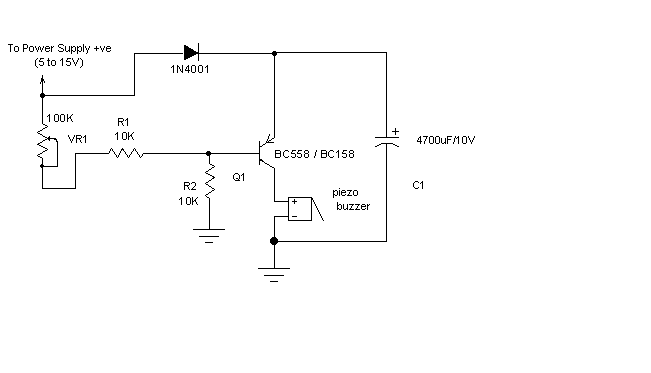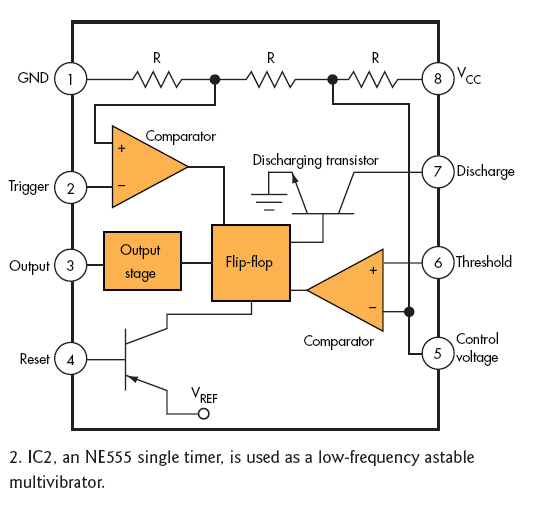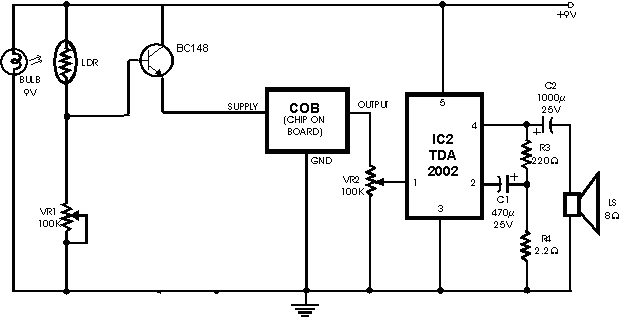
cmos 4060 burglar alarm
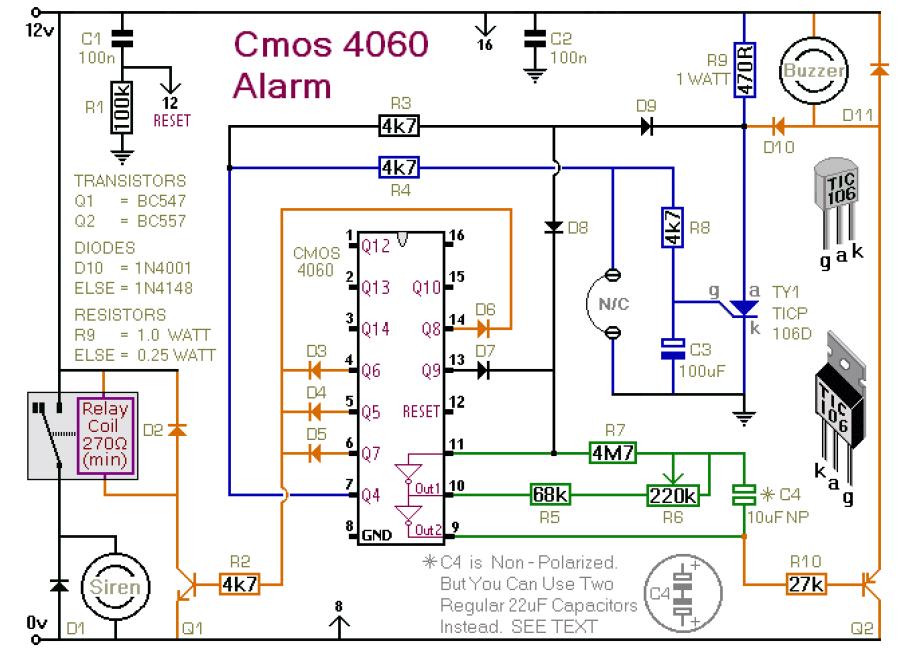
This is a single-zone alarm system equipped with automatic exit, entry, and siren cut-off timers. It supports various types of normally-closed input devices, including magnetic reed contacts, foil tape, and passive infrared sensors (PIRs). The circuit is designed to operate with a 12-volt supply, although it is compatible with voltages ranging from 5 to 15 volts. Users can select a siren, buzzer, and relay that match their chosen voltage. Upon activation, the alarm buzzer emits eight beeps, indicating the exit delay period. During this time, individuals can exit the premises without triggering the alarm. The duration and frequency of the beeps are controlled by resistor R6, which can be adjusted to provide an exit delay ranging from approximately ten seconds to one minute. After the eighth beep, the buzzer stops, confirming that the loop is intact. If the buzzer continues to sound, it indicates an open loop, prompting users to check for unsecured doors or windows. Upon re-entry, the buzzer will sound again, initiating the entry delay, which matches the exit delay duration but is indicated by a continuous beep. Failure to deactivate the alarm before the entry delay expires will result in the siren sounding once. The siren cut-off delay is set to 30 times the exit delay duration, meaning that if the exit delay is set to 30 seconds, the siren will sound for approximately 15 minutes before shutting off. After the siren cut-off, the buzzer continues to sound, indicating that the alarm has been triggered. Diode D10 is optional; it ensures the buzzer sounds continuously during the entry delay and continues after the siren has stopped. If omitted, the buzzer will beep eight times during both exit and entry delays and cease when the siren cuts off. The circuit also includes a polarized electrolytic capacitor, which can be susceptible to damage if connected incorrectly. Resistor R5 is included to prevent potential failure, but using a non-polarized capacitor is advisable for reliable oscillator operation. A non-polarized 10uF capacitor can be simulated by connecting two 22uF polarized capacitors in a back-to-back configuration.
This single-zone alarm system is designed to provide comprehensive security for a designated area. The automatic exit, entry, and siren cut-off timers enhance user convenience and system reliability. The ability to accommodate various normally-closed input devices allows for flexibility in installation and use, making it suitable for different security applications.
The circuit operates within a voltage range of 5 to 15 volts, which allows for compatibility with common power supplies. The choice of a siren, buzzer, and relay tailored to the selected voltage ensures that users can customize the system to meet specific requirements. The exit delay feature, indicated by the eight beeps, is crucial for allowing users to exit the premises without triggering the alarm. The adjustable resistor R6 provides versatility in setting the exit delay, which can be tailored to individual preferences or security needs.
The confirmation mechanism that the loop is intact, indicated by the cessation of the buzzer after the exit delay, is an essential feature. It alerts users to any potential security breaches, ensuring that they can address any open points before leaving the premises. The entry delay, which mirrors the exit delay but is indicated by a continuous beep, provides a clear auditory signal that alerts users while they re-enter the secured area.
The siren cut-off timer, which is significantly longer than the exit delay, ensures that in the event of an alarm activation, the siren provides a prolonged alert to deter unauthorized access. The continued sounding of the buzzer after the siren has stopped serves as a reminder of the alarm's activation status, prompting users to investigate.
The inclusion of diode D10, while optional, enhances the functionality of the system by ensuring that the buzzer remains active during critical phases of the alarm cycle. This feature can be particularly useful in environments where audible alerts are necessary for user awareness.
The circuit's design also incorporates protective measures for components such as the electrolytic capacitor. The presence of resistor R5 mitigates the risk of capacitor failure due to incorrect polarity, while the recommendation for a non-polarized capacitor ensures that the oscillator operates reliably. The innovative solution of connecting two polarized capacitors back-to-back to simulate a non-polarized capacitor demonstrates a practical approach to circuit design, ensuring both functionality and reliability.
Overall, this single-zone alarm system offers a robust and flexible solution for enhancing security, with features designed to accommodate user needs and protect critical components effectively.This is a single zone alarm - with automatic exit, entry and siren cut-off timers. It will accommodate all the usual types of normally-closed input devices - such as magnetic-reed contacts - foil tape - PIRs etc. I`ve used a 12-volt supply in the drawing - but the circuit will work at anything from 5 to 15-volts.
All you need do is select a siren, buzzer, and relay to suit the voltage you`re using. When you switch the alarm on - the buzzer will sound eight times. This is the exit delay. Before the end of the eighth beep - you can leave the building without activating the alarm. R6 controls the length and speed of the beeps. It can be adjusted to give an exit delay of anything from about ten seconds - up to about a minute. After the eighth beep - the buzzer should stop sounding. This confirms that the loop has been restored within the time allowed. If the buzzer does not stop - but changes instead to a continuous beep - the loop is open and the building isn`t secure. When this happens - you should switch off the alarm - and check for open doors, windows etc. When you return and open the door - the buzzer will sound again - and the entry delay will start. The entry delay is the same length as the exit delay. But to distinguish it from the exit delay - the buzzer will sound continuously. If the buzzer is sounding continuously - the alarm has been activated - and the entry delay has begun.
If you don`t switch the alarm off before the entry delay expires - the siren will sound. The siren will sound only once. Just as R6 sets the lengths of the exit and entry delays - it also sets the siren cutoff time. The siren cut-off delay is 30 times the length of the exit delay. With the exit delay set at 30-seconds - the siren will sound for about 15-minutes. Then it will switch off - and remain off. After the cut-off timer has switched the siren off - the buzzer will continue to sound. So when you return - if the buzzer is sounding - you`ll know that the alarm has been activated. Note that D10 is optional. Its job is to sound the buzzer constantly during the entry delay. It`s also responsible for keeping the buzzer going after the siren has stopped. If you leave out D10 - the buzzer will beep eight times during both the exit and entry delays. And - when the siren cuts-off - the buzzer will cut off also. A regular electrolytic capacitor is polarised. If the charge on its plates is the wrong way round - DC current will flow through the capacitor. If the current is high enough - the capacitor will heat up and explode. The presence of R5 in the circuit means that this is not going to happen. But if you use a polarised capacitor - it may mean that the oscillator won`t run - or won`t run reliably. While the oscillator is running - the polarity of the charge on C4 keeps reversing. So C4 needs to be nonpolarised. However - you can simulate a non-polarised 10uF capacitor by connecting two 22uF polarised capacitors back to back - as shown.
🔗 External reference
This single-zone alarm system is designed to provide comprehensive security for a designated area. The automatic exit, entry, and siren cut-off timers enhance user convenience and system reliability. The ability to accommodate various normally-closed input devices allows for flexibility in installation and use, making it suitable for different security applications.
The circuit operates within a voltage range of 5 to 15 volts, which allows for compatibility with common power supplies. The choice of a siren, buzzer, and relay tailored to the selected voltage ensures that users can customize the system to meet specific requirements. The exit delay feature, indicated by the eight beeps, is crucial for allowing users to exit the premises without triggering the alarm. The adjustable resistor R6 provides versatility in setting the exit delay, which can be tailored to individual preferences or security needs.
The confirmation mechanism that the loop is intact, indicated by the cessation of the buzzer after the exit delay, is an essential feature. It alerts users to any potential security breaches, ensuring that they can address any open points before leaving the premises. The entry delay, which mirrors the exit delay but is indicated by a continuous beep, provides a clear auditory signal that alerts users while they re-enter the secured area.
The siren cut-off timer, which is significantly longer than the exit delay, ensures that in the event of an alarm activation, the siren provides a prolonged alert to deter unauthorized access. The continued sounding of the buzzer after the siren has stopped serves as a reminder of the alarm's activation status, prompting users to investigate.
The inclusion of diode D10, while optional, enhances the functionality of the system by ensuring that the buzzer remains active during critical phases of the alarm cycle. This feature can be particularly useful in environments where audible alerts are necessary for user awareness.
The circuit's design also incorporates protective measures for components such as the electrolytic capacitor. The presence of resistor R5 mitigates the risk of capacitor failure due to incorrect polarity, while the recommendation for a non-polarized capacitor ensures that the oscillator operates reliably. The innovative solution of connecting two polarized capacitors back-to-back to simulate a non-polarized capacitor demonstrates a practical approach to circuit design, ensuring both functionality and reliability.
Overall, this single-zone alarm system offers a robust and flexible solution for enhancing security, with features designed to accommodate user needs and protect critical components effectively.This is a single zone alarm - with automatic exit, entry and siren cut-off timers. It will accommodate all the usual types of normally-closed input devices - such as magnetic-reed contacts - foil tape - PIRs etc. I`ve used a 12-volt supply in the drawing - but the circuit will work at anything from 5 to 15-volts.
All you need do is select a siren, buzzer, and relay to suit the voltage you`re using. When you switch the alarm on - the buzzer will sound eight times. This is the exit delay. Before the end of the eighth beep - you can leave the building without activating the alarm. R6 controls the length and speed of the beeps. It can be adjusted to give an exit delay of anything from about ten seconds - up to about a minute. After the eighth beep - the buzzer should stop sounding. This confirms that the loop has been restored within the time allowed. If the buzzer does not stop - but changes instead to a continuous beep - the loop is open and the building isn`t secure. When this happens - you should switch off the alarm - and check for open doors, windows etc. When you return and open the door - the buzzer will sound again - and the entry delay will start. The entry delay is the same length as the exit delay. But to distinguish it from the exit delay - the buzzer will sound continuously. If the buzzer is sounding continuously - the alarm has been activated - and the entry delay has begun.
If you don`t switch the alarm off before the entry delay expires - the siren will sound. The siren will sound only once. Just as R6 sets the lengths of the exit and entry delays - it also sets the siren cutoff time. The siren cut-off delay is 30 times the length of the exit delay. With the exit delay set at 30-seconds - the siren will sound for about 15-minutes. Then it will switch off - and remain off. After the cut-off timer has switched the siren off - the buzzer will continue to sound. So when you return - if the buzzer is sounding - you`ll know that the alarm has been activated. Note that D10 is optional. Its job is to sound the buzzer constantly during the entry delay. It`s also responsible for keeping the buzzer going after the siren has stopped. If you leave out D10 - the buzzer will beep eight times during both the exit and entry delays. And - when the siren cuts-off - the buzzer will cut off also. A regular electrolytic capacitor is polarised. If the charge on its plates is the wrong way round - DC current will flow through the capacitor. If the current is high enough - the capacitor will heat up and explode. The presence of R5 in the circuit means that this is not going to happen. But if you use a polarised capacitor - it may mean that the oscillator won`t run - or won`t run reliably. While the oscillator is running - the polarity of the charge on C4 keeps reversing. So C4 needs to be nonpolarised. However - you can simulate a non-polarised 10uF capacitor by connecting two 22uF polarised capacitors back to back - as shown.
🔗 External reference
Warning: include(partials/cookie-banner.php): Failed to open stream: Permission denied in /var/www/html/nextgr/view-circuit.php on line 713
Warning: include(): Failed opening 'partials/cookie-banner.php' for inclusion (include_path='.:/usr/share/php') in /var/www/html/nextgr/view-circuit.php on line 713
